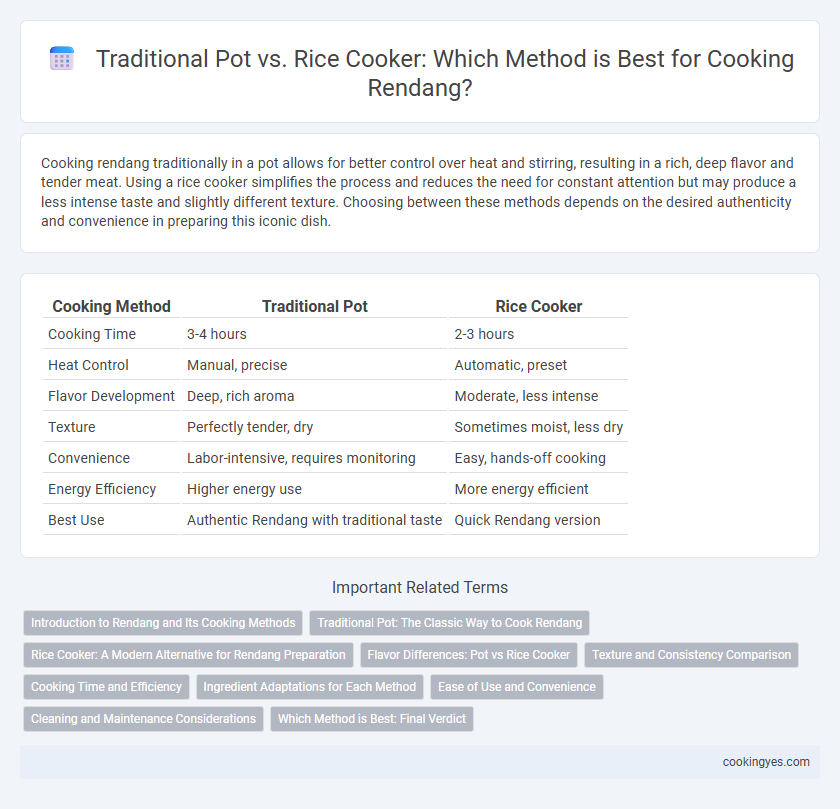Cooking rendang traditionally in a pot allows for better control over heat and stirring, resulting in a rich, deep flavor and tender meat. Using a rice cooker simplifies the process and reduces the need for constant attention but may produce a less intense taste and slightly different texture. Choosing between these methods depends on the desired authenticity and convenience in preparing this iconic dish.
Table of Comparison
| Cooking Method | Traditional Pot | Rice Cooker |
|---|---|---|
| Cooking Time | 3-4 hours | 2-3 hours |
| Heat Control | Manual, precise | Automatic, preset |
| Flavor Development | Deep, rich aroma | Moderate, less intense |
| Texture | Perfectly tender, dry | Sometimes moist, less dry |
| Convenience | Labor-intensive, requires monitoring | Easy, hands-off cooking |
| Energy Efficiency | Higher energy use | More energy efficient |
| Best Use | Authentic Rendang with traditional taste | Quick Rendang version |
Introduction to Rendang and Its Cooking Methods
Rendang, a rich and flavorful Indonesian dish made from slow-cooked beef simmered in coconut milk and a blend of aromatic spices, traditionally requires hours of careful preparation to develop its deep, complex taste. Cooking in a traditional pot over low heat allows for gradual evaporation of liquid and intense caramelization of spices, enhancing the dish's authenticity and texture. Using a rice cooker offers a modern, convenient alternative, though it may lack the nuanced control and slow reduction essential for achieving the classic Rendang's signature dry, tender consistency.
Traditional Pot: The Classic Way to Cook Rendang
Cooking rendang in a traditional pot allows for slow, even heat distribution essential to developing deep, rich flavors and tender meat texture. The manual control over heat intensity enables gradual evaporation of coconut milk, creating the signature thick, caramelized sauce unique to authentic rendang. This classic method preserves the dish's cultural authenticity and enhances the complexity that modern appliances like rice cookers often cannot replicate.
Rice Cooker: A Modern Alternative for Rendang Preparation
Rice cookers offer a modern alternative for rendang preparation by providing consistent temperature control, which helps achieve tender meat and rich flavors without constant supervision. This method reduces cooking time significantly compared to the traditional pot, making it convenient for busy households. While the slow-cooked authenticity of traditional pots is prized, rice cookers efficiently replicate the complex taste and texture of rendang using automated heating cycles.
Flavor Differences: Pot vs Rice Cooker
Traditional pot cooking of Rendang infuses deeper, richer flavors due to slow, consistent simmering that allows spices to fully meld with the meat and coconut milk. Rice cookers, while convenient, often produce a milder taste as the controlled temperature and shorter cooking time limit the caramelization and reduction processes essential for authentic Rendang flavor. The pot method creates complex, layered taste profiles with a thicker sauce, whereas the rice cooker yields a lighter, less concentrated dish.
Texture and Consistency Comparison
Traditional pot cooking enhances rendang's texture by allowing slow evaporation and steady heat distribution, resulting in thicker, richly caramelized sauce with tender, well-infused meat fibers. Rice cookers accelerate the process but may produce a slightly more watery consistency and less developed depth in texture due to controlled, automated temperature settings. For authentic rendang, the manual control over heat and longer simmering times in a traditional pot yield superior texture and consistency.
Cooking Time and Efficiency
Traditional pot cooking of rendang involves slow simmering over several hours, typically 4 to 6 hours, allowing deep flavor development and tender meat. Rice cookers offer a more automated approach with shorter cooking times, around 2 to 3 hours, but may lack the same depth of flavor due to less consistent heat and reduced evaporation. Efficiency is higher with rice cookers from an energy and convenience perspective, while traditional pots provide superior taste through gradual reduction and controlled heat.
Ingredient Adaptations for Each Method
Traditional pot cooking for Rendang allows slow evaporation and intense flavor development, requiring careful ingredient layering and frequent stirring to prevent burning. In contrast, using a rice cooker simplifies the process by maintaining consistent heat, often necessitating adjustments such as reduced liquid quantities and finely ground spices to accommodate its sealed environment. Ingredient adaptations, like using softened coconut milk and pre-toasted spice blends, ensure optimal texture and aroma in both methods.
Ease of Use and Convenience
Cooking rendang in a traditional pot allows for precise control over heat and simmering time, which is essential for achieving its rich, caramelized flavors and tender texture. Using a rice cooker offers convenience with preset cooking cycles, reducing active monitoring and making it easier for beginners. However, the rice cooker may lack the nuanced heat adjustments needed to fully develop rendang's complex taste compared to the manual control provided by a traditional pot.
Cleaning and Maintenance Considerations
Traditional pots used for cooking rendang typically require manual scrubbing to remove thick, caramelized residues, which can be time-consuming and may cause wear over time. Rice cookers offer a non-stick surface or easy-to-clean components that simplify maintenance, reducing the effort needed for cleaning after slow-cooking processes. Choosing a rice cooker can minimize post-cooking cleanup, while traditional pots demand more rigorous cleaning to maintain their quality and longevity.
Which Method is Best: Final Verdict
Traditional pot cooking for rendang offers superior flavor development through slow, consistent simmering, allowing spices and meat to fully meld over several hours. Rice cookers provide convenience and controlled heat but often lack the depth of taste and texture achieved by the traditional method. For authentic rendang, the traditional pot remains the best choice to achieve rich, tender, and deeply aromatic results.
Traditional Pot vs Rice Cooker for Cooking Method Infographic

 cookingyes.com
cookingyes.com